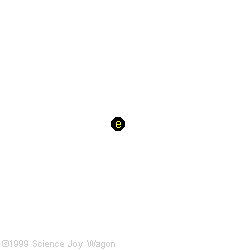Photon Particle Collisions - The Compton Effect
In 1922 Aurthur Compton was able to bounce an X-ray photon off an electron. The result was an electron with more kinetic energy than it started with, and an X-ray with less energy than it started with. A photon can actually interact with a particle! A photon has momentum!! There are 4 things you should notice from this animation:

- The frequency and consequently the energy of the photon is higher before the collision. After the collision, some energy has been transferred to the electron. This leaves the photon having a lower frequency after the collision.
- Since wavelength is inversely related to frequency, the wave has a lower frequency after the collision.
- Energy is conserved before and after this collision.
- Momentum is conserved before and after this collision.
The formula for the momentum of a photon is written as  where p is momentum, h is Planck's constant and
where p is momentum, h is Planck's constant and ![]() is the wavelength of the photon.
is the wavelength of the photon.
This experiment quickly demonstrated problem with "looking at" electrons. The very act of "shining light" on it causes the electron to be altered by the very photons that are allowing us to "see the electron."
